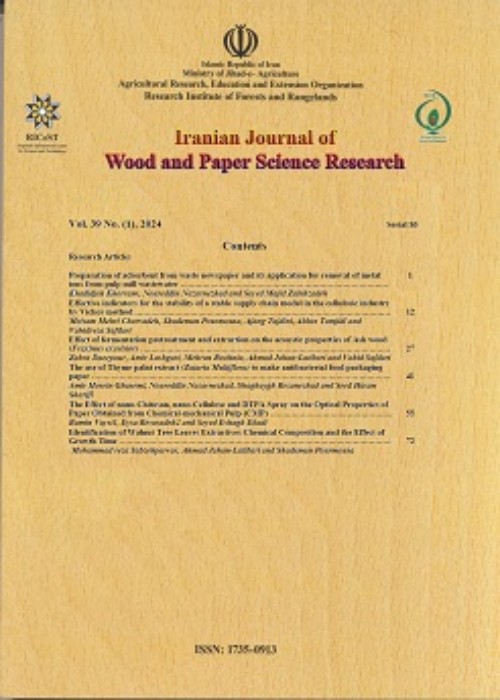The influence of beech wood drying condition on its pH, buffering capacity and UF bond strength
Author(s):
Abstract:
In this investigation، the surface chemical properties of the beech wood layers were characterized and the impact of drying condition on the strength of the bond was examined. Defect free beech logs were harvested and then the layers were prepared. The moisture content of the specimens were adjusted at 30، 40 and 50% (dry basis) and then the specimens were air dried under the environment of 30% relative humidity and 21ºC to reach the equilibrium moisture content of about 10% (dry basis). The pH and buffering capacity of the surface layer and the layer 0. 5 mm underneath the surface were measured. The dried specimens were bonded using urea-formaldehyde resin and the tensile strength and wood failure were measured using relevant ASTM method. The results showed that as the moisture content prior to air drying was increased، the tensile strength was reduced، but the effect of this variable on tensile strength was not statistically significant. However، the effect of moisture content on wood failure was statistically significant at 99% significance level. The effect of the pH of the under layer on both tensile strength and wood failure was statistically significant at 95%. As the moisture content of the wood increased، the pH of the surface layer increased and the strength of the bond with urea-formaldehyde resin was deteriorated. At higher initial moisture of the wood، the alkaline buffering capacity of the surface layer was lower and its effect of the strength was not statistically significant، but it was significant on wood failure at 99% level. The alkaline buffering capacity of under layer was also changed and statistically affected the bond strength and wood failure at 95% level. The higher alkaline buffering capacity of the under layer adversely affected the tensile strength of the bond. The lowest acid buffering capacity was measured from specimens with 40% initial moisture content and as the acid buffering capacity was increased، the tensile strength was reduced and the wood failure was higher. The impact of surface layer acid buffering capacity on tensile strength was on statistically significant، but on wood failure was statistically significant at 99% level.
Keywords:
Language:
Persian
Published:
Iranian Journal of Wood and Paper Science Research, Volume:29 Issue: 2, 2014
Pages:
275 to 286
magiran.com/p1286394
دانلود و مطالعه متن این مقاله با یکی از روشهای زیر امکان پذیر است:
اشتراک شخصی
با عضویت و پرداخت آنلاین حق اشتراک یکساله به مبلغ 1,390,000ريال میتوانید 70 عنوان مطلب دانلود کنید!
اشتراک سازمانی
به کتابخانه دانشگاه یا محل کار خود پیشنهاد کنید تا اشتراک سازمانی این پایگاه را برای دسترسی نامحدود همه کاربران به متن مطالب تهیه نمایند!
توجه!
- حق عضویت دریافتی صرف حمایت از نشریات عضو و نگهداری، تکمیل و توسعه مگیران میشود.
- پرداخت حق اشتراک و دانلود مقالات اجازه بازنشر آن در سایر رسانههای چاپی و دیجیتال را به کاربر نمیدهد.
In order to view content subscription is required
Personal subscription
Subscribe magiran.com for 70 € euros via PayPal and download 70 articles during a year.
Organization subscription
Please contact us to subscribe your university or library for unlimited access!


